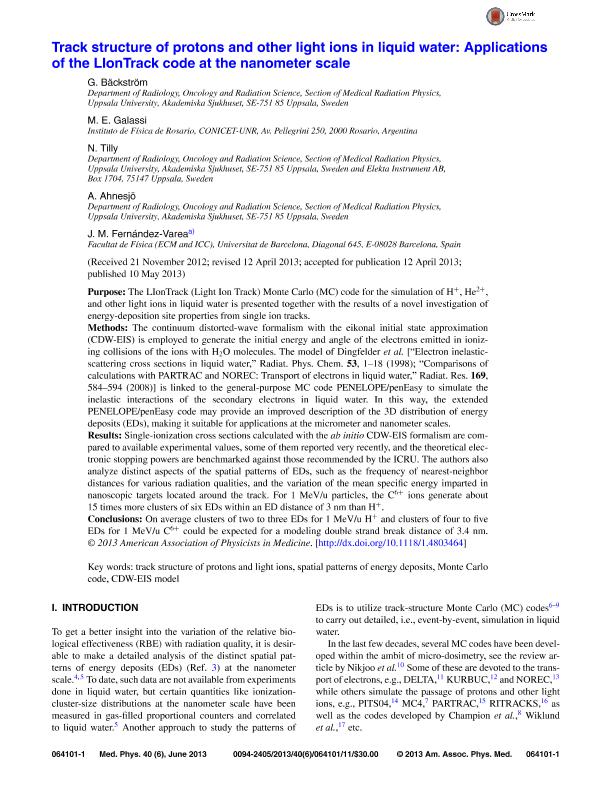Mostrar el registro sencillo del ítem
dc.contributor.author
Bäckström, Gloria
dc.contributor.author
Galassi, Mariel Elisa

dc.contributor.author
Tilly, N.
dc.contributor.author
Ahnesjö, A.
dc.contributor.author
Fernandez Varea, J. M.
dc.date.available
2016-05-31T17:26:07Z
dc.date.issued
2013-05-10
dc.identifier.citation
Bäckström, Gloria; Galassi, Mariel Elisa; Tilly, N.; Ahnesjö, A.; Fernandez Varea, J. M.; Track structure of protons and other light ions in liquid water: Applications of the LIonTrack code at the nanometer scale; American Institute of Physics; Medical Physics; 40; 6; 10-5-2013; 064101-064101
dc.identifier.issn
0094-2405
dc.identifier.uri
http://hdl.handle.net/11336/5948
dc.description.abstract
The LIonTrack (Light Ion Track) Monte Carlo (MC) code for the simulation of H+, He2+, and other light ions in liquid water is presented together with the results of a novel investigation of energy-deposition site properties from single ion tracks. Methods:The continuum distorted-wave formalism with the eikonal initial state approximation (CDW-EIS) is employed to generate the initial energy and angle of the electrons emitted in ionizing collisions of the ions with H2O molecules. The model of Dingfelder et al. [Electron inelastic scattering cross sections in liquid water, Radiat. Phys. Chem. 53, 1-18 (1999); Comparisons of calculations with PARTRAC and NOREC: Transport of electrons in liquid water, Radiat. Res. 169, 584-594 (2008)] is linked to the general-purpose MC code PENELOPE/penEasy to simulate the inelastic interactions of the secondary electrons in liquid water. In this way, the extended PENELOPE/penEasy code may provide an improved description of the 3D distribution of energy deposits (EDs), making it suitable for applications at the micrometer and nanometer scales. Single-ionization cross sections calculated with the ab initio CDW-EIS formalism are compared to available experimental values, some of them reported very recently, and the theoretical electronic stopping powers are benchmarked against those recommended by the ICRU. The authors also analyze distinct aspects of the spatial patterns of EDs, such as the frequency of nearest-neighbor distances for various radiation qualities, and the variation of the mean specific energy imparted in nanoscopic targets located around the track. For 1 MeV/u particles, the C6+ ions generate about 15 times more clusters of six EDs within an ED distance of 3 nm than H+. On average clusters of two to three EDs for 1 MeV/u H+ and clusters of four to five EDs for 1 MeV/u C6+ could be expected for a modeling double strand break distance of 3.4 nm.
dc.format
application/pdf
dc.language.iso
eng
dc.publisher
American Institute of Physics

dc.rights
info:eu-repo/semantics/openAccess
dc.rights.uri
https://creativecommons.org/licenses/by-nc-sa/2.5/ar/
dc.subject
Ions
dc.subject
Microdosimetry
dc.subject
Monte Carlo
dc.subject.classification
Física Atómica, Molecular y Química

dc.subject.classification
Ciencias Físicas

dc.subject.classification
CIENCIAS NATURALES Y EXACTAS

dc.title
Track structure of protons and other light ions in liquid water: Applications of the LIonTrack code at the nanometer scale
dc.type
info:eu-repo/semantics/article
dc.type
info:ar-repo/semantics/artículo
dc.type
info:eu-repo/semantics/publishedVersion
dc.date.updated
2016-05-27T19:42:39Z
dc.journal.volume
40
dc.journal.number
6
dc.journal.pagination
064101-064101
dc.journal.pais
Estados Unidos

dc.journal.ciudad
Nueva York
dc.description.fil
Fil: Bäckström, Gloria. Uppsala University. Section of Medical Radiation Physics. Department of Radiology, Oncology and Radiation Science; Suecia
dc.description.fil
Fil: Galassi, Mariel Elisa. Consejo Nacional de Investigaciones Científicas y Técnicas. Centro Científico Tecnológico Rosario. Instituto de Física de Rosario (i); Argentina
dc.description.fil
Fil: Tilly, N.. Uppsala University. Section of Medical Radiation Physics. Department of Radiology, Oncology and Radiation Science; Suecia
dc.description.fil
Fil: Ahnesjö, A.. Uppsala University. Section of Medical Radiation Physics. Department of Radiology, Oncology and Radiation Science; Suecia
dc.description.fil
Fil: Fernandez Varea, J. M.. Universidad de Barcelona. Facultad de Física; España
dc.journal.title
Medical Physics

dc.relation.alternativeid
info:eu-repo/semantics/altIdentifier/url/http://scitation.aip.org/content/aapm/journal/medphys/40/6/10.1118/1.4803464
dc.relation.alternativeid
info:eu-repo/semantics/altIdentifier/url/http://dx.doi.org/10.1118/1.4803464
Archivos asociados
